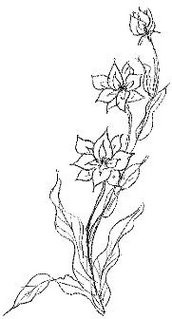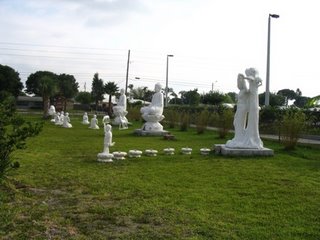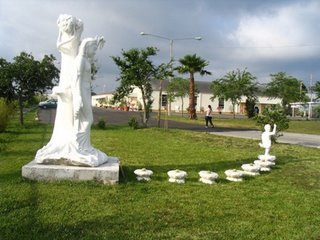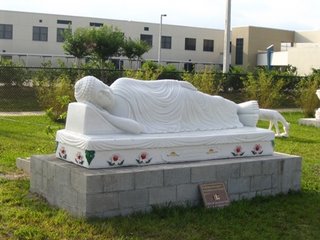
While not as many as in, say Taiwan or even Malaysia, Florida has its fair share of Buddhist temples too. However, there is one aspect that is not found in the former two localities, namely, its diversity with respect to the national affiliation. So we have here, among others, Chinese temples, Thai temples, Sri Lankan temples, and Vietnamese temples.
As ethnic Chinese, we have been frequenting Chinese temples, principally because of the language barrier. Despite the fact that Buddhism, as is the case for other religions, transcends national and language boundaries, as a practical matter there is a need to transmit the various forms of Buddhist teaching in different languages so that people from myriad background can understand and hence benefit from the teaching. While the ancient sutras are written in Pali and Sanskrit, they have been translated into many languages and the tendency is for each temple to display translated sutras and other Buddhist texts as per its national origin. Until one day, that is, when we were brought to a Vietnamese temple right across the Tampa Bay from us.
What is unique about this temple is the tapestry of white sculptures sprawling over the front lawn. Each cluster depicts a historical event in the life of Siddhārtha Gautama, the Supreme Buddha and the historical founder of Buddhism, sort of like a three-dimensional life size rendition.
The image below shows the arrangement of the three clusters of sculptures, each corresponding to an important phase of the life of the Buddha. Next, I will show a closeup of each cluster, starting chronologically from the foreground of this image accompanied by a brief account of the significance of the event depicted.

The first image shows what happened not long after the birth of Siddhārtha Gautama where he walked seven steps from his mother, Queen Maya, and declared with his hand pointing skyward, "The sky above and the groud below, I'm the only Supreme." This is my attempt at literally translating from a chinese text. However, the "I" as articulated by the Buddha is not to be construed narrowly as the first person I, but rather it refers to our original inner self. Therein lies one of the distinguishing elements of Buddhism that we are all capable of being fully awakened or enlightened, in Buddhist parlance. This is a state of complete liberation from suffering and afflictions.
The day of the Buddha's birth is widely celebrated as Vesak, not only in Buddhist countries, but also in Malaysia where Islam is the official religion but freedom of worship is guaranteed under the Constitution.

Despite being born as a prince and having lived in the palace for 29 years in comfort, Siddhārtha Gautama was troubled and left his family and possessions in search of ways to ovecome human suffering.
After trying and abandoning asceticism, he concentrated on meditation and was said to have achieved enlightenment while sitting under a Bodhi tree at the age of 35. At first, he was undecided whether to deliver the dharma (the teachings of the Buddha) as he was concerned that the many human failings (greed, hatred, and delusion) would prevent human beings from understanding the true dharma, but he was asked to teach the dharma to the world by a divine spirit.
At the Deer Park in northern India, he set in motion the Wheel of Dharma by delivering his first sermon to the group of five companions with whom he had previously sought enlightenment as depicted in the second image below. They, together with the Buddha, formed the first saṅgha, the company of Buddhist monks.

The Buddha continued his teaching of the dharma for forty nine years and entered Parinirvana, the final deathless state leaving the earthly body, in his early 80s. This great passing of the Buddha is depicted in the third image below. The final pose that the Buddha struck is reputed to be the best sleeping position to facilitate a dreamless rest when complemented by an affliction-free state of mind.

The arrangement of the various sculptures, which embody the gist of the inspiring life of the great Buddha, has left a lasting impression on me. It is also the prime motivation for me to learn more about buddhism by attending dharma talks, reading books on buddhism, and listening to tapes and audio CDs of Buddhist mantras. While I've not been ordained into Buddhism nor undergone the ritual of the five precepts like my wife has, I feel that in mind and body I'm already in the process of making the compassion, the virtue, the humility, and the giving, the core values enshrined in the Buddhist teachings, as my moral compass. Nevertheless, I look forward to the day when I will be pleasantly surprised at finally making the plunge into the embrace of Buddhism in ritual to formalize the transition.
(I would like to acknowledge that I've paraphrased some of the texts contained in several articles related to Buddhism at the Wikipedia website as referenced above and the Buddha.)
P.S. I forgot to include the name of the Vietnamese temple where the sculptures are located. Here it is.


2 comments:
Great to see and visit your blog please send some on my bolg dhammasasana.blogspot.com
Thanks for visiting.
Yes, I will definitely visit your blog to share experiences.
It's sad that Buddhism has not flourished in India, its birth place.
But it has given the world the Great Buddha.
Post a Comment